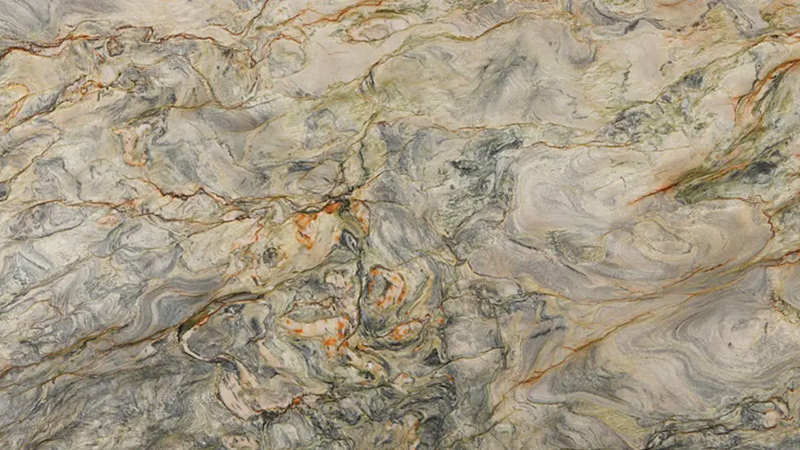
Quartzite"s durability makes it ideal for construction projects. "
Quartzite is a natural metamorphic rock that forms from sandstone under intense heat and pressure. It is composed primarily of quartz, which is one of the most abundant minerals in the Earth's crust. The transformation from sandstone to quartzite occurs when the sandstone is buried deep within the Earth's crust and subjected to high temperatures and pressure, causing the grains of quartz to recrystallize and fuse together. Quartzite is known for its durability and hardness, making it a popular choice for various applications, particularly in the construction industry. It is often used as a dimension stone for countertops, flooring, wall cladding, and other decorative purposes. Quartzite's hardness and resistance to chemical weathering make it suitable for high-traffic areas where durability is essential.
Quartzite forms when sandstone is subjected to intense heat and pressure deep within the Earth's crust. The pressure causes the sand grains to recrystallize and bind together, forming a solid rock. The presence of silica-rich fluids during the metamorphic process helps cement the grains together, resulting in the hard and durable nature of quartzite. Quartzite is renowned for its hardness and durability. It ranks high on the Mohs scale of mineral hardness, typically ranging from 7 to 8. This makes it harder than many other natural stones like marble and limestone, and comparable to materials like granite. Its durability makes quartzite resistant to scratching, abrasion, and heat, making it suitable for various applications.
One of the distinguishing features of quartzite is its appearance. It typically has a granular texture with a range of colors, including white, gray, yellow, pink, and red. The presence of iron oxide can give quartzite a reddish or rusty hue. Quartzite can also exhibit unique patterns and veining due to the geological processes it undergoes during its formation. It is important to note that quartzite should not be confused with quartz, which is an engineered stone made by combining natural quartz crystals with resins and pigments. While both materials are quartz-based, they have different properties and origins. Quartzite is a natural stone, whereas quartz is a man-made product.
Quartzite is a very hard metamorphic rock that has been formed due to the metamorphism of sandstone due to high pressure and heat in the earth's crust. Most quartzite rocks are made of a substance called quartz. This stone has different shapes and is composed of different sizes.
This stone has a rough surface and is crystalline at the same time. White quartzite has a similar appearance to marble but is more resistant than marble. Quartzite rock is a natural rock that is obtained due to high pressure and extreme heat, which causes the particles to be compressed to each other and eventually stick together and firmly, resulting in quartzite rock. Quartzite stone can be used for exterior and interior facades, as well as for repairing walls and floors. Compared to many other rocks, quartzite is resistant to cold and heat, acidic materials and abrasion and does not disappear over time.
Quartzite exhibits a wide range of colors and patterns due to the impurities present during its formation. The dominant mineral in quartzite is quartz, which is colorless and transparent. However, other minerals and impurities can impart a variety of hues. For example, iron oxide can create shades of red, pink, and yellow, while other minerals can introduce gray, white, or even green tones. The intricate veining and patterns found in quartzite are a result of the geological processes and mineral variations. Quartzite's exceptional durability and attractive appearance make it a popular choice for both residential and commercial applications. It is commonly used as a natural stone for kitchen countertops, bathroom vanities, and flooring. Its resistance to heat and staining makes it suitable for kitchen environments. Quartzite is also employed in wall cladding, fireplace surrounds, and outdoor paving due to its ability to withstand weathering and external elements.

